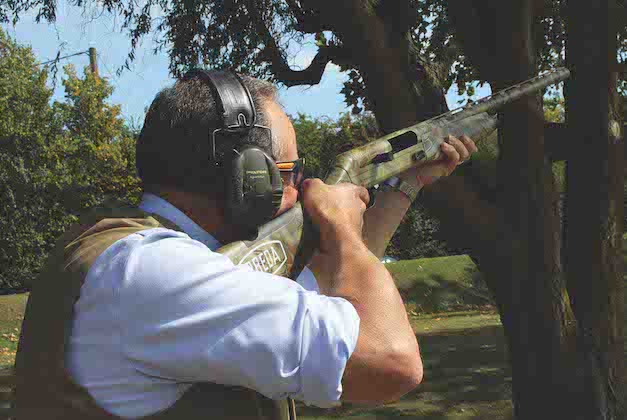Hatsan Escort Magnum semi-automatic shotgun
Semi-autos are a bit Marmite. You either love them or hate them. There’s no grey area. Turn up with one…
Win CENS ProFlex DX5 earplugs worth £1,149 – enter here

This month’s gun on test is a 12-bore with a pretty impressive name: Breda 3.5in Super Magnum in Kryptek Mandrake camouflage.
Researching the camouflage pattern revealed it’s designed for hunting in dark timber or Georgia pines and excels in dark forest surroundings or the jungle. I’m not sure the average goose, duck or pigeon will have any respect for this camo pattern, so it’s lucky the gun also comes in black.

Now it’s test time. I was under time pressure as it was the last week of August and the diary for lessons had gone into overdrive. At the end of a hot and busy day on both clays and rifle range, I picked up a few 21g cartridges, some 28g competition cartridges that are some of the fastest on the market, and some 36g No5s.
I went down to an area where we have a wide variety of clays and, as expected, the 21g cartridges refused to cycle. However, very surprisingly, the punchy 28g competition cartridges also refused to cycle. The 36g No5s cycled without a hitch and a variety of targets, including some at long range, were duly sorted. The gun had no handling vices but the test was less than satisfactory.
I decided on a second test after a raid on my cartridge supplies produced a different competition brand in 28g, then a variety of 30g and 32g game/pigeon loads, including a box of Eley Grand Prix 30g No6 from the last century, still with the price label on of £2.95. Before discount that would be a 250 rate of under £30 — if only they were that price now.
However the prize find was a box of 1⅞oz, approximately 52g, copper-plated No4s — definitely what the doctor ordered. Who better to lend a hand than Steve Walton, the former Commonwealth Games gold medallist and one of our instructors.
There are a number of competitors in this market including the Winchester SX4, plus various offerings from Beretta and Benelli. It’s a question of personal preference.
Fortunately, there was only one failure to recycle on the first shot and then it didn’t miss a beat. Everything went through, including the slightly corroded Grand Prix. We saved the best until last: the 52g No4s. We opted for a rabbit target for safety reasons and shot fall-out, and I have never seen a target so completely destroyed — I was surprised there wasn’t a crater in the ground.
Steve shot a few targets with a variety of loads then the artillery rounds, and couldn’t stop himself laughing as a result. We finished with some simultaneous trios and the semi-auto kept up with pulling of the trigger. Handling was predictable and there were good patterns with half-choke. The recoil on everything was well managed.
Semi-autos are a bit Marmite. You either love them or hate them. There’s no grey area. Turn up with one…
Semi-auto shotguns under £1500: Rarely seen on a driven day, semi-automatic shotguns feature some of the most advanced technology in
Some of the older recoil operated semi-automatic shotguns based on the Browning A5 have a simple method of friction ring…
This is a well made semi-automatic that’s easy to operate but potentially a little fussy in the cartridge department. I would expect a semi-auto to routinely cycle 28g and upwards. The camouflage pattern is something of an acquired taste.
Get the latest news delivered direct to your door
Discover the ultimate companion for field sports enthusiasts with Shooting Times & Country Magazine, the UK’s leading weekly publication that has been at the forefront of shooting culture since 1882. Subscribers gain access to expert tips, comprehensive gear reviews, seasonal advice and a vibrant community of like-minded shooters.
Save on shop price when you subscribe with weekly issues featuring in-depth articles on gundog training, exclusive member offers and access to the digital back issue library. A Shooting Times & Country subscription is more than a magazine, don’t just read about the countryside; immerse yourself in its most authoritative and engaging publication.

